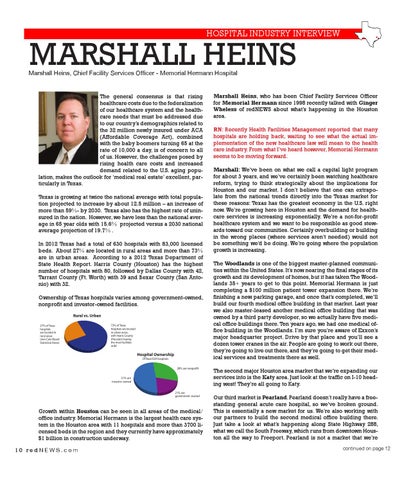Hospital Industry INTERVIEW
MARSHALL HEINS
Marshall Heins, Chief Facility Services Officer - Memorial Hermann Hospital
The general consensus is that rising healthcare costs due to the federalization of our healthcare system and the healthcare needs that must be addressed due to our country’s demographics related to the 32 million newly insured under ACA (Affordable Coverage Act), combined with the baby boomers turning 65 at the rate of 10,000 a day, is of concern to all of us. However, the challenges posed by rising health care costs and increased demand related to the U.S. aging population, makes the outlook for ‘medical real estate’ excellent, particularly in Texas. Texas is growing at twice the national average with total population projected to increase by about 12.5 million – an increase of more than 59%- by 2030. Texas also has the highest rate of uninsured in the nation. However, we have less than the national average in 65 year olds with 15.6% projected versus a 2030 national average projection of 19.7% . In 2012 Texas had a total of 630 hospitals with 83,000 licensed beds. About 27% are located in rural areas and more than 73% 2 0 1 2 - 2 0 1 3to a 2012 Texas Department of are in urban areas. According on State Health Report. Harris County (Houston) has the highest number of hospitals with 80, followed by Dallas County with 42, Tarrant County (Ft. Worth) with 39 and Bexar County (San Anto2 0 1nio) 2 - 2 0 1with 3 32. on
FAST FACTS Texas Hospitals
FAST FACTS Rural vs. Urban Texas Hospitals Ownership of Texas hospitals varies among government-owned, 27% of Texas hospitals
nonprofit and investor-owned facilities. are located in Rural vs. Urban 27% of Texas hospitals Rural vs. Urban are located in rural areas (non-Core Based 27% of Texas Statistical Areas) Of Texas’ 630 hospitals: hospitals are located in rural areas (non-Core Based Statistical Areas)
Hospital Ownership
Hospital Ownership 51% are investor- owned
Rural vs. Urban
rural areas (non-Core Based 27% of Texas Statistical Areas) Of Texas’ 630 hospitals: hospitals are located in rural areas 73% of Texas (non-Core Based hospitals are located Statistical Areas) in urban areas, with Harris County (Houston) having 73% of Texas the most facilities hospitals are located at 80 in urban areas, with Harris County (Houston) having the most facilities at 80 51% are investor- owned
51% are 28% are nonprofit investor- owned
Hospital Ownership
Hospital Ownership
73% of Texas hospitals are located in urban areas, with Harris County (Houston) having 73% of Texas the most facilities hospitals are located at 80 in urban areas, with Harris County (Houston) having the most facilities at 80
28% are nonprofit
Of Texas’ 630 hospitals: 28% are nonprofit 21% are government- owned
Of Texas’ 630 hospitals:
51% are investor- owned
28% are nonprofit 21% are government- owned
21% are government- owned
Growth within Houston can be seen in all areas of the medical/ office industry. Memorial Hermann is the largest health care sys21% are government- owned tem in the Houston area with 11 hospitals and more than 3700 licensed beds in the region and they currently have approximately $1 billion in construction underway.
10 redNEWS.com
Marshall Heins, who has been Chief Facility Services Officer for Memorial Hermann since 1998 recently talked with Ginger Wheless of redNEWS about what’s happening in the Houston area. RN: Recently Health Facilities Management reported that many hospitals are holding back, waiting to see what the actual implementation of the new healthcare law will mean to the health care industry. From what I’ve heard however, Memorial Hermann seems to be moving forward. Marshall: We’ve been on what we call a capital light program for about 3 years, and we’ve certainly been watching healthcare reform, trying to think strategically about the implications for Houston and our market. I don’t believe that one can extrapolate from the national trends directly into the Texas market for these reasons: Texas has the greatest economy in the U.S. right now. We’re growing here in Houston and the demand for healthcare services is increasing exponentially. We’re a not-for-profit healthcare system and we want to be responsible as good stewards toward our communities. Certainly overbuilding or building in the wrong places (where services aren’t needed) would not be something we’d be doing. We’re going where the population growth is increasing. The Woodlands is one of the biggest master-planned communities within the United States. It’s now nearing the final stages of its growth and its development of homes, but it has taken The Woodlands 35+ years to get to this point. Memorial Hermann is just completing a $100 million patient tower expansion there. We’re finishing a new parking garage, and once that’s completed, we’ll build our fourth medical office building in that market. Last year we also master-leased another medical office building that was owned by a third party developer, so we actually have five medical office buildings there. Ten years ago, we had one medical office building in the Woodlands. I’m sure you’re aware of Exxon’s major headquarter project. Drive by that place and you’ll see a dozen tower cranes in the air. People are going to work out there, they’re going to live out there, and they’re going to get their medical services and treatments there as well. The second major Houston area market that we’re expanding our services into is the Katy area. Just look at the traffic on I-10 heading west! They’re all going to Katy. Our third market is Pearland. Pearland doesn’t really have a freestanding general acute care hospital, so we’ve broken ground. This is essentially a new market for us. We’re also working with our partners to build the second medical office building there. Just take a look at what’s happening along State Highway 288, what we call the South Freeway, which runs from downtown Houston all the way to Freeport. Pearland is not a market that we’re continued on page 12
